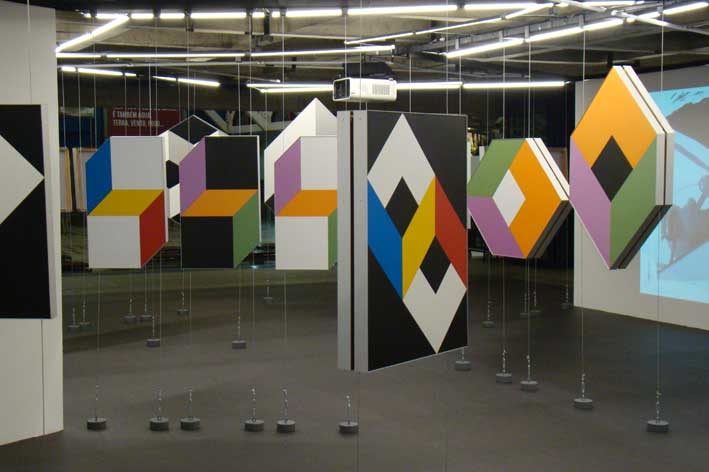In a slightly too-small space, to he’s-behind-you chants from a children’s performance in the room next door, the setting for this exhibition of two groups of works by the artist Geraldo de Barros (1923–98) is São Paulo’s SESC Vila Mariana, one of an egalitarian network of art and leisure centres (SESCS) that spans the length and breadth of Brazil. SESC, which owns a number of de Barros’s works, has also just published a book covering the entire trajectory of the photographer, painter and designer’s career, Geraldo de Barros: Isso.
That simultaneous mystery and simplicity at the heart of geometry are the foundations of de Barros’s lifetime spent as an artist and designer
Mounted on wires stretched from ceiling to floor, the 55 geometric sculptural forms of de Barros’s Jogos de Dados (Games of Dice, 1980s) dominate the space, hanging in clusters facing this way and that. Close to the centre, the originating piece, Pai de Todos (Father of Them All), is a hexagon comprising 12 rhombuses, pristine in its mathematical precision, the simplicity of its black, white and grey colours, and its smooth, almost textureless expanses of Formica.
De Barros, who was also a founder of the furniture companies Unilabor (a workers’ cooperative) and Hobjeto, made Jogos de Dados after the first of a series of strokes robbed him of the power of speech. Simple and unproblematic at first glance, the virtual planes created by the Formica shapes impact on you slowly, as your vision cycles through the possible changes in perspective, feeling the flat planes turn concave, then convex, then flat again.
That simultaneous mystery and simplicity at the heart of geometry are the foundations of de Barros’s lifetime spent as an artist and designer. Starting out as a painter, he began also working in photography in 1946, going on to create the exquisite series of abstract images ‘Fotoformas’.
Using his camera, a twin-lens Rolleiflex 6×6, as well as manipulating negatives by superimposing, scratching and painting on them, de Barros drew photography into his practice as a highly creative form of printmaking. The success of those experiments, ironically, took him away from photography: a 1950 exhibition, Fotoformas, at Museu de Arte de São Paulo led to a period of scholarship in France and Germany, where he turned to painting again, leaving aside photography as a medium for the next 40 years.
Following a career that saw him play a leading role in Brazil’s Concretist movement, and a 1960s Pop art period, as well as furniture design, he returned to photography at age seventy-three, two years before his death, when, albeit further debilitated by strokes, he created Sobras (Leftovers, 1996–8), the second series in this SESC exhibition.
the mildly dystopian works are full of voids real and imaginary
From boxes of mainly family snapshots, plus a few remnants of the ‘Fotoformas’ material, de Barros sliced into negatives, reimagining what must have been deeply familiar scenes to make the more than 200 artworks, displayed in this exhibition as slides projected onto two screens, with a third screen showing parts of the process of their creation.
A cat, eyes glowing in the flash, crouches on top of a wardrobe, a web of incisions crisscrossing the space overhead. Areas of static are introduced into skies, onto horizons and radiating around people. A small boy in spectacles cycles along a pavement, into a void formed by a neatly excised rectangle in the centre of the photo.
A man looks over battlements at a featureless abyss – a sky that has been sliced away. Unsettling, and exquisitely executed with the aid of de Barros’s assistant, the photographer Ana Moraes, the mildly dystopian works are full of voids real and imaginary, faces caught off-guard in snapshots, and inspire complicated ideas about memory, family and life; about geometry, maths and science; and perhaps even about fuses blown along neural pathways, waiting to swallow people up.
This review originally appeared in the October 2013 issue.
